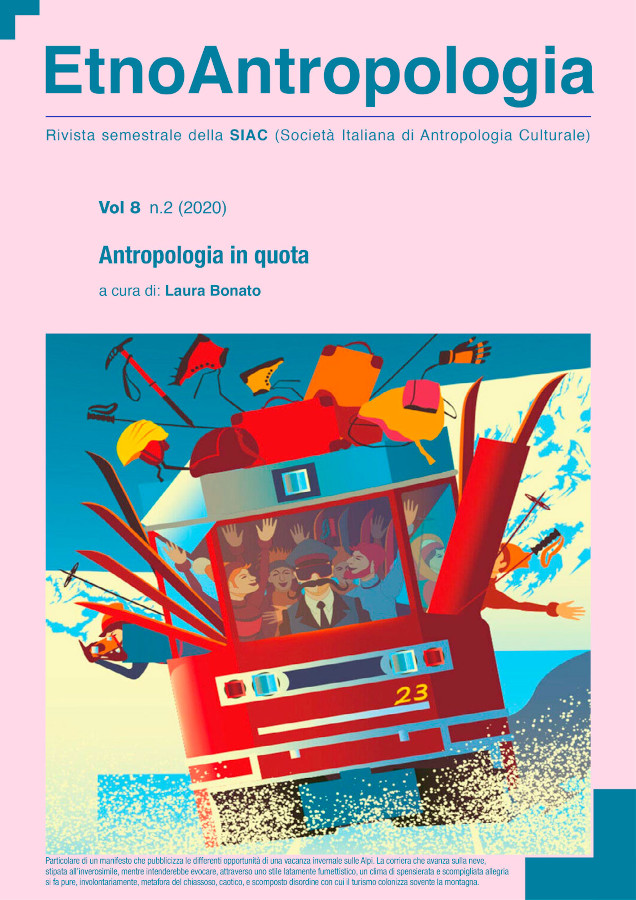Condividere il bosco. Un confronto tra regimi del patrimonio in Val di Fiemme
Parole chiave:
Fiemme Valley, Heritage regimes, Community forestry, Cultural landscape, Alpine tourismAbstract
This article aims to consider the historical transition between different forest heritage regimes in the Fiemme Valley. For most of its nine-century history, the community of Fiemme managed its woodland as a commons, a self-organized, long-enduring, and self-governed system of resources. This type of regime began to change as early as the 18th century, under the pressure of influential commercial companies and the administrative reorganization of the post-Napoleonic states. Nowadays, joint forest management and alpine tourism are shaping a new heritage regime, based on sustainability and the valorization of the forests.
Riferimenti bibliografici
Agnoletti M. 2018, Storia del bosco. Il paesaggio forestale italiano, Roma-Bari: Laterza.
Agnoletti M., Biasi R. 2013, Trentino Alto-Adige, in Agnoletti M. (ed.) 2013, Italian Historical Rural Landscapes. Cultural Values for the Environment and Rural Development, Berlin: Springer, 247-262.
Bendix R. F., Eggert A., Peselmann A. 2013, Introduction: Heritage Regimes and the State, in Bendix R. F., Eggert A., Peselmann A. (eds.) 2013, Heritage Regimes and the State, Göttingen: Universitätsverlag Göttingen, 11-20.
Breman P., et. al. 2010, Central Region, in Pröbstl U., et. al. (eds.) 2010, Management of Recreation and Nature Based Tourism in European Forests, Berlin: Springer, 73-96.
Bonan G. 2016, The communities and the comuni. The implementation of administrative reforms in the Fiemme Valley (Trentino, Italy) during the first half of the 19th century, «International Journal of the Commons», 10: 589-616.
Bonato L., Viazzo P. P. (eds.) 2013, Antropologia e beni culturali nelle Alpi: studiare, valorizzare, restituire, Alessandria: Edizioni dell'Orso.
Bushell R. 2015, Heritage and Sustainable Development: Transdisciplinary Imaginings of a Wicked Concept, in Waterton E., Watson S. (eds.) 2015, The Palgrave Handbook of Contemporary Heritage Research, Basingstoke: Palgrave Macmillan, 492-508.
Cattoi S., Pollini C., Tosi V. 2000, Case study: Multifunctionality in the Fiemme Valley, Italian Alps in Price M. F., Butt N. (eds.) 2000, Forests in Sustainable Mountain Development: a State of Knowledge Report for 2000, Wallingford: CABI, 203-206.
Charnley S., Poe M. R. 2007, Community Forestry in Theory and Practice: Where Are We Now?, «Annual Review of Anthropology», 36: 301-336.
Chirici G., et. al. 2019, Stima dei danni della tempesta “Vaia” alle foreste in Italia, «Forest@. Rivista di Selvicoltura ed Ecologia Forestale», 16: 3-9.
Convenzione delle Alpi [CA] 2013, Turismo sostenibile nelle Alpi. Quarta relazione sullo stato delle Alpi, Innsbruck: Segretariato permanente della Convenzione delle Alpi.
Coombe R. J. 2013, Managing Cultural Heritage as Neoliberal Governmentality, in Bendix R. F., Eggert A., Peselmann A. (eds.) 2013, Heritage Regimes and the State, Göttingen: Universitätsverlag Göttingen, 375-388.
De Moor T. 2011, From Common Pastures to Global Commons: A Historical Perspective on Interdisciplinary Approaches to Commons, «Natures Sciences Sociétés», 19: 422–431.
Degiampietro C. 1975, Cronache fiemmesi attraverso nove secoli, Trento: Manfrini.
Geismar H. 2015, Anthropology and Heritage Regimes, «Annual Review of Anthropology», 44: 71-85.
Giordani I. 1998, La Magnifica Comunità di Fiemme. Sintesi storica, «Dendronatura», 19 (1): 7-26.
Jeanrenaud S. 2001, Communities and Forest Management in Western Europe, Gland: IUCN.
Manfriani M. 2018, Tempesta Vaia. Anche la selvicoltura ha le sue colpe, «Italian Journal of Forest and Mountain Environments» 73 (6): 261-265.
McKean, M. A. 2000, Common Property: What Is It, What Is It Good for, and What Makes It Work?, in Gibson C. C., McKean M. A., Ostrom E. (eds.) 2000, People and Forests Communities, Institutions, and Governance, Cambridge and London: The MIT Press, 27-56.
Menzies N. K. 2007, Our Forest, Your Ecosystem, Their Timber: Communities, Conservation, and the State in Community-based forest management, New York: Columbia University Press.
Moran E. 2005, Human-Environment Interactions in Forest Ecosystems: An Introduction, in Moran E., Ostrom E. (eds.) 2005, Seeing the Forest and the Trees Human-Environment Interactions in Forest Ecosystems, Cambridge (USA): MIT Press, 3-22.
Morandini, R. 1996, A Modern Forest-dependent community: the Magnifica Comunità di Fiemme in Italy, «Unasylva», 47: 47-52.
Netting R. 1981, Balancing on an Alp, Cambridge: Cambridge University Press.
Ostrom E. 1990, Governing the Commons. The Evolution of Institutions for Collective Actions, Cambridge: Cambridge University Press.
Pilati C. A. 1786, Eccezioni della Comunità di Fiemme contro il nuovo Statuto [...], Trento: s.n.
Sartori Montecroce T. 2002, La Comunità di Fiemme e il suo diritto statuario, Cavalese: MCF.
Simonicca A. 2006, Viaggi e comunità. Prospettive antropologiche, Milano: Meltemi.
Stronza A. 2001, Anthropology of Tourism: Forging New Ground for Ecotourism and Other Alternatives, «Annual Review of Anthropology», 30: 261-283.
Tommasini D. 2017, Contro la marginalità e l’abbandono montano: l’agriturismo in Alto Adige fra tradizione, creatività e politiche, in Bonato L. (ed.) 2017, Aree marginali: sostenibilità e saper fare nelle Alpi, Milano: Franco Angeli, 183-193.
Pubblicato
Come citare
Fascicolo
Sezione
Licenza
Copyright (c) 2021 Nicola Martellozzo

TQuesto lavoro è fornito con la licenza Creative Commons Attribuzione 4.0 Internazionale.
Gli autori mantengono i diritti sulla loro opera e cedono alla rivista il diritto di prima pubblicazione dell'opera, contemporaneamente licenziata sotto una Licenza Creative Commons - Attribuzione che permette ad altri di condividere l'opera indicando la paternità intellettuale e la prima pubblicazione su questa rivista.
Gli autori possono diffondere la loro opera online (es. in repository istituzionali o nel loro sito web) prima e durante il processo di submission, poiché può portare a scambi produttivi e aumentare le citazioni dell'opera pubblicata (Vedi The Effect of Open Access).





